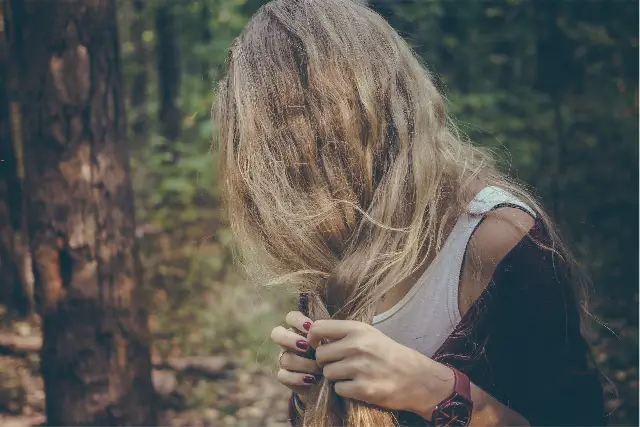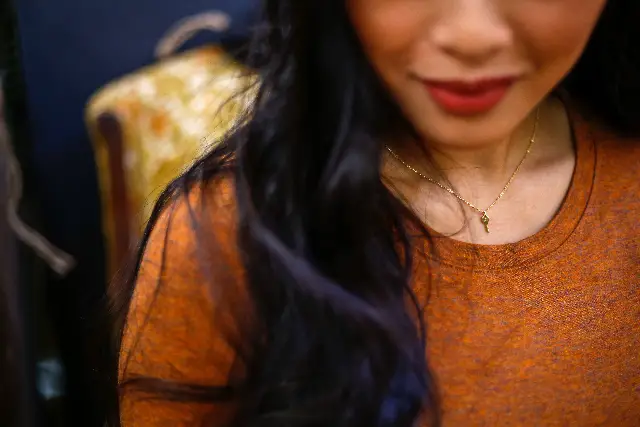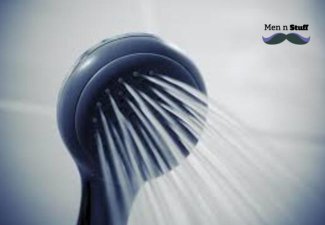Last Updated on January 8, 2024 by Chase Reiner
Hair toppers are beneficial for thin hair. Pros include instant volume and coverage, boosting confidence. However, the cons involve potential discomfort and maintenance. About 30 million women in the US alone experience hair loss, making toppers a popular solution.
Jump To A Section
What is Thin Hair?
When we talk about thin hair, we’re referring to the diameter of each strand. Fine hair has a small diameter, while thick hair has a large diameter. But it’s not just the diameter that determines whether your hair is fine or thick – it’s also the number of strands on your head.
If you have fewer strands of hair, your hair is considered thin. Therefore, if you have more strands of hair, your hair is considered thick. Of course, there are different degrees of thinness and thickness, and everybody’s definition of thin hair will be different. But generally speaking, you might consider your hair thin if you have less hair than you want.
So, are hair toppers good for thin hair? The answer is complicated. On the one hand, if you wear a topper over thin hair, the result will look like thicker hair! That can give people with thinner hair an instant confidence boost because they won’t feel they stand out as much from their peers who may have thicker locks.
However, wearing a topper over thin hair can make those with very few strands of natural hair feel self-conscious because they will know that their real scalp shows through the top layer of fibers, which often looks dry and flaky due to friction caused by daily use.
Can You Wear A Hair Topper On Natural Hair?
Undoubtedly, hair toppers have emerged as a popular accessory for those experiencing hair loss or thinning hair. But can you wear a hair topper on natural hair? The answer is, absolutely yes! However, to maximize the benefits and minimize potential drawbacks, it’s important to consider some key aspects. Here’s a list of critical points to ponder when deciding to adorn a hair topper on natural hair.
1. Compatibility with Natural Hair
Before opting for a hair topper, examine its compatibility with your natural hair. Take into account elements like color, density, texture, and length. Ideally, the topper should blend seamlessly with your own hair to appear as natural as possible.
2. Proper Attachment
How you attach the topper to your natural hair is crucial. The right method ensures security and comfort. Clip-in hair toppers are commonly preferred due to their ease of attachment and removal.
3. Comfort and Ease
As you will be wearing the topper for extended periods, comfort should be prioritized. A comfortable hair topper will allow your scalp to breathe, prevent itching, and alleviate discomfort.
4. Quality Matters
Quality is paramount when it comes to hair toppers. Ideally, always choose 100% human hair toppers. They are more durable, can be styled like natural hair, and offer a better aesthetic appeal.
5. Care for Your Natural Hair
While enjoying the benefits of a hair topper, remember not to neglect your natural hair. Proper care and maintenance of your existing hair is essential for a long-lasting and healthy mane.
6. Professional Assistance
When getting started, professional assistance can make the process smooth and manageable. A stylist experienced in handling hair toppers can provide valuable guidance on choosing and maintaining them.
| Key Points | Description |
|---|---|
| Compatibility | Match color, density, length, and texture |
| Attachment | Clip-ins are preferred for easy application |
| Comfort | Ensure your scalp breathes freely |
| Quality | Choose 100% human hair for better results |
| Natural Hair Care | Nourish your real hair while using a topper |
| Professional Help | Seek guidance from an expert stylist |

How Hair Toppers Work on Thin Hair
Hair toppers are becoming an increasingly popular solution for women with thinning hair. But what are they, and do they really work?
Hair toppers are made of either human or synthetic hair and act as a temporary way to camouflage balding spots. They’re attached via either adhesive or small clips onto the existing hair on your head, making them look like the person has more of it than they actually do.
It is not meant to be a permanent fix; instead, it’s a way for people with thinning hair to go about their daily lives without being constantly self-conscious about their appearance.
Types of Hair Toppers
Several different types of hair toppers can be used to add volume and fullness to thin hair.
- Clip-in hair toppers are the most popular type, as they are easy to use and can be removed when you want.
- Tape-in hair toppers are another option, but they require more care and can be more challenging to remove.
- Halo-type hair toppers are also an option, but they can be less comfortable to wear.
- Human hair toppers (toupees) are made from natural human hair and can make your scalp look fuller. However, these toppers will often cost quite a bit more than other options and may not last as long.
- Synthetic hair toppers may have similar benefits but with a lower price tag. They’re also easier to find in stores if you need them quickly.
There’s no right or wrong answer about which type of hair topper is best – it all depends on what you’re looking for!
Choosing the Right Topper for Your Thin Hair
Selecting a suitable hair topper for your thin hair can be nerve-wracking. However, it will become a breeze if you follow the guidelines discussed below:
1. Decide Whether You’ll Go for Fiber or Human Hair
The critical factor in deciding which type of hair topper is best for you is the look you want to achieve. Human hair is always the best route if you want a natural look. But if you’re looking for more volume or want to experiment with color, fiber might be the better option.
There are also benefits and cons to each type regarding care and maintenance. Human hair needs to be shampooed, conditioned, and styled just like your own hair, while fiber hair can be left as-is or lightly styled with products specifically for synthetic hair.

2. Determine Your Hair Length
Determining your hair length is the first step in deciding if a hair topper is right for you.
- If you have short hair, a topper may not be necessary.
- A topper can give you the volume and coverage you need if you have medium-length hair.
- If you have long hair, a topper can help add volume and thickness.
Thicker or longer hair may require more than one topper. A hair topper can be added on top of another layer of thinning areas or at the front of the head where thinning is most evident. They must be secured well with clips or pins so they don’t shift around while you wear them!
3. Choose the Base
When attaching hair toppers to your thin hair, there are two bases to choose from wefted and monofilament. Considering the benefits and disadvantages would be ideal before deciding which is best for you.
The wefted base attaches the top to the scalp with an adhesive, meaning it can’t be removed easily or without damaging the hair underneath. This base provides excellent hair ventilation, thus, optimal comfort.
Monofilament attaches at the top of the head with a lace closure that goes over the natural hairline, making it easier to remove if necessary. The monofilament base is ideal if you are experiencing severe or complete hair loss.
4. Choose the Right Color
When it comes to hair toppers, one of the most important things to consider is color. You want to ensure that your chosen color matches your natural hair color as closely as possible. Otherwise, it will look unnatural and obvious. If you’re unsure what color to choose, consult a professional stylist.
The Pros of Using Hair Toppers on Thin Hair
- Hair toppers are a temporary solution to thinning hair.
- They are less expensive than other options such as surgery.
- They are easy to style and use with natural hair.
- They are less likely to cause scalp irritation.
- Some people find they have an instant confidence boost when wearing them.
- Rare cases of allergic reactions.
The Side Effects (Cons) of Using Hair Toppers on Thin Hair
Although hair toppers can be a quick fix for thinning hair, they can also have some adverse side effects:
- If not applied correctly, they can cause scalp irritation.
- The adhesive may contain chemicals that could irritate sensitive skin.
- Their weight is concentrated in one area – it can lead to bald spots on the scalp.
- Finally, certain hairstyles don’t work with hair toppers because they need an even thickness across all of your head.

Can You Wear A Hair Topper Year-Round?
When it comes to adding volume, length, or covering hair loss, hair toppers are the go-to solution for many. These versatile hairpieces are designed to seamlessly blend in with your natural hair, giving you a beautiful and effortless look. But can you wear a hair topper year-round? Let’s find out.
- Material Matters:
Hair toppers are typically made from either synthetic or human hair. Synthetic hair toppers are more affordable and require less maintenance. However, they may not withstand heat styling as well as human hair toppers. On the other hand, human hair toppers offer the most natural look and can be styled or colored just like your own hair. - Climate Considerations:
When deciding whether you can wear a hair topper year-round, it’s essential to think about the climate you live in. If you reside in a region with extreme temperatures or high humidity, you may want to opt for a lightweight and breathable hair topper. This will ensure comfort and prevent excessive sweating. - Lifestyle and Activities:
Your lifestyle and activities play a crucial role in determining if you can wear a hair topper throughout the year. If you engage in regular physical activities or sports that may cause excessive sweating, consider choosing a hair topper that is easy to remove and clean. Additionally, if you frequently swim or engage in water-based activities, ensure your hair topper is waterproof. - Securing Methods:
Hair toppers can be attached using various securing methods such as clips, combs, tape, adhesive, or micro-links. Consider the securing method that works best for you and your lifestyle. Some methods allow for easier removal and cleaning, while others offer better stability and longevity. - Seasonal Styles:
Wearing a hair topper year-round allows you to experiment with different hairstyles depending on the season. In colder months, you may opt for longer and thicker toppers to provide warmth and protection. During warmer months, you can choose shorter and lighter toppers for comfort and a cooler feel. - Hair Care and Maintenance:
To ensure you can wear your hair topper year-round, proper care and maintenance are crucial. Regularly washing, conditioning, and styling your hair topper will maintain its appearance and longevity. Follow the manufacturer’s guidelines for care instructions specific to the type of hair topper you have. - Confidence Boost:
One of the most significant benefits of wearing a hair topper year-round is the confidence boost it provides. Regardless of the season, having a beautifully styled hair topper can enhance your overall appearance, boost self-esteem, and improve your quality of life.
In conclusion, the answer to whether you can wear a hair topper year-round depends on various factors such as material, climate, lifestyle, securing methods, and hair care. With the right choice of hair topper and proper maintenance, you can enjoy the benefits of wearing a hair topper throughout the year, allowing you to look and feel your best every day.
The Takeaway
So, are hair toppers good for thin hair? It depends on your situation. Suppose you have thinning hair or experiencing hair loss; a topper can be a great way to add volume and coverage. Nonetheless, other options may be better suited if you’re looking for a way to add some extra fullness to your hair. Weigh the benefits and cons carefully before making a decision, and consult with a professional stylist if possible.
References:
https://www.uniwigs.com/blog/what-are-the-pros-and-cons-of-wearing-a-hair-topper.html
https://www.hairtoppers.com/blogs/news/are-hair-toppers-bad-for-your-hair

Hi, this is Chase Reiner from Idaho, USA. I am very passionate about fashion, My blog is all about exploring the latest fashion trends for men. I am a fashion lover and I love finding out what the hottest trends are and sharing all these in this MenNStuff.Com

